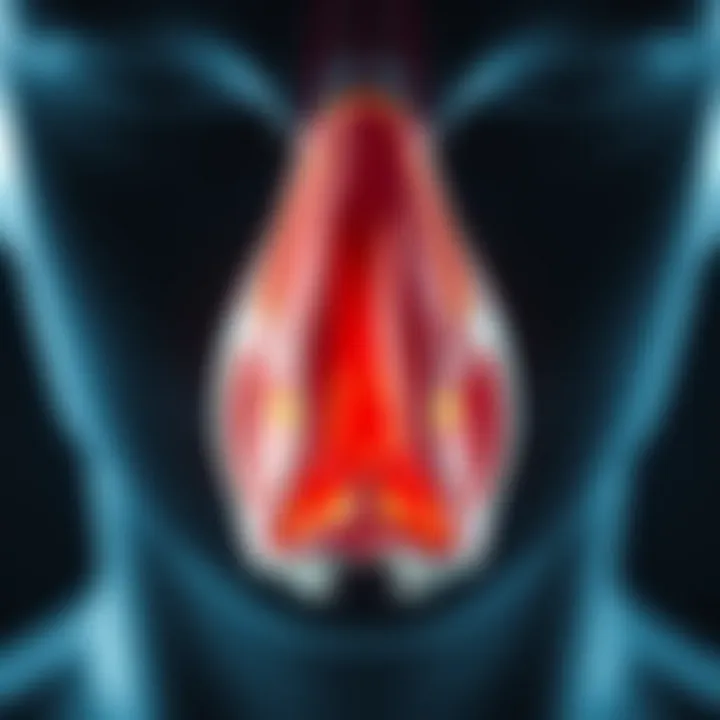Techniques for Effective Nasal Clearance and Health


Intro
In the pursuit of maintaining optimal health, one often overlooks the significance of nasal hygiene. The nose is not just a passage for air; it plays a vital role in filtering pathogens, regulating airflow, and hydrating inhaled air. When nasal passages become congested with mucus or allergens, it can impair these functions, leading not only to discomfort but also to potential complications. Through understanding effective techniques for nasal clearance, individuals can engage in practices that promote better breathing and enhance overall well-being.
Nasal clearance strategies range from simple home remedies to more involved techniques that may require specialized knowledge. This guide aims to usher you through various methods, all while ensuring you’re equipped with knowledge of the anatomical considerations that underpin these practices. By implementing the best practices outlined here, anyone can take proactive steps toward robust sinus health.
Prelims to Nasal Hygiene
Nasal hygiene is often overshadowed by more obvious health topics, yet it plays a pivotal role in maintaining overall well-being. The nose is not merely a passageway for air; it's a sophisticated organ that prepares the air we breathe, filters out impurities, and plays a crucial role in our immune response. Understanding nasal hygiene goes beyond mere cleaning; it encompasses recognizing how our nasal passages function, how they can become clogged, and what can be done to keep them clear.
Importance of Nasal Health
Maintaining nasal health is crucial for several reasons. First and foremost, the nasal passages are our body's first line of defense against airborne pathogens and pollutants. By ensuring that these passages are clean and functioning well, we bolster our immune system's ability to combat infections.
Moreover, proper nasal hygiene can significantly impact our quality of life. Many people suffer from excess mucus or congestion, which can lead to difficulty breathing, reduced sleep quality, and generally feeling unwell. Addressing these issues through effective nasal care can lead to improvements in mood, focus, and even physical performance.
For those with allergies or sensitivities, nasal hygiene becomes even more paramount. Regular cleansing can aid in reducing allergens and irritants, allowing for a more comfortable daily existence.
The Physiological Role of Mucus
Mucus, often viewed as a bothersome substance, is actually a vital component of our respiratory health. Produced by goblet cells in the lining of the nasal passages, mucus has several essential functions. One of its primary roles is to trap dust, particles, and pathogens, preventing them from entering the lungs. In this sense, mucus acts as a protective barrier against potential infections.
Additionally, mucus helps to maintain moisture in the nasal passages, which is crucial for protecting delicate tissues and ensuring effective respiration. Without sufficient mucus, the nasal passages can become dry and irritated, making them more susceptible to infection and inflammation.
Interestingly, the consistency and quality of mucus can change due to various factors such as diet, hydration, and environmental conditions. Keeping an eye on these elements can significantly influence how mucus functions in your nasal system.
"A healthy nose is a gateway to a healthy body—keep it clean, and it will serve you well."
Understanding Nasal Anatomy
Understanding the anatomy of the nasal passages is an essential first step in managing nasal health and effectively clearing mucus. The design of these structures not only influences how air travels through our respiratory system, but it also plays a crucial part in filtering out irritants, pathogens, and allergens. When it comes to addressing nasal congestion or mucus build-up, a clear understanding of nasal anatomy can help one identify effective techniques tailored to individual needs, enhancing overall respiratory function.
Structure of the Nasal Passages
The nasal passages consist of a complex arrangement of bones and cartilage, lined with a mucous membrane that plays a pivotal role in maintaining respiratory health. Their main purpose is to provide a pathway for air, allowing for inhalation and exhalation while also warming, humidifying, and filtering the air.
- Nasal Cavity: The large hollow space behind the nose is divided into two halves by the nasal septum. Each side comprises structures known as the turbinates.
- Turbinates: These are bony structures covered with mucous membranes. They increase the surface area of the nasal cavity, allowing the incoming air to be humidified and warmed efficiently. Each turbinate also plays a role in trapping particles, supporting the body's defense mechanisms.
- Sinuses: These air-filled cavities are connected to the nasal passages and contribute to voice resonance. They also help lighten the skull and provide a buffer against facial trauma.
- Nasal Septum: This consists of cartilage and bone, separating the left and right nasal cavities. A deviated septum can lead to breathing difficulties and increased mucus retention, which can be problematic in achieving nasal clearance.
The geometry of the nasal passages can influence airflow dynamics significantly. A common example is how a blockage, whether by swelling or excess mucus, can lead to a sensation of congestion. This knowledge can guide individuals in determining when effective techniques such as nasal irrigation or steam inhalation might be necessary.
Mechanisms of Mucus Production
Mucus production is vital for the overall function of the nasal passages. Goblet cells and submucosal glands within the nasal lining are responsible for this production, which serves several critical purposes. Understanding these mechanisms can shine a light on why the body reacts in certain ways and how to address congestive issues effectively.
- Protection: Mucus traps dust, allergens, and pathogens that enter through inhalation. This sticky substance helps prevent them from entering the lower respiratory tract, minimizing infections and irritation.
- Hydration: Mucus keeps the mucosal surfaces of the nasal passages moist, essential for optimal function and protection of underlying tissues.
- Ciliary Function: Tiny hair-like structures known as cilia work in conjunction with mucus. They continuously sweep small particles trapped in mucus toward the throat, where they can be swallowed or expelled. An impairment in ciliary function can lead to stagnant mucus and increased risk of sinus infections.
In summary, the intricate anatomy and functional mechanics of the nasal passages and mucus production highlight the importance of maintaining nasal hygiene and health. Understanding these foundations can empower individuals to make informed choices about their respiratory techniques and ensure their nasal clearance practices are not only effective but also supportive of overall well-being.
"Knowledge of nasal structure and function is the cornerstone for effective management of nasal health."
For further insights on the anatomy of the nasal cavity, consider visiting Britannica or the Wikipedia page on Nasal Anatomy.
Engaging with credible resources can enhance one's understanding of this essential aspect of human biology.
Identifying Causes of Excess Mucus


Understanding the root causes of excess mucus production is essential for managing nasal health effectively. Without knowing what triggers the overproduction, individuals may struggle to find relief or even exacerbate their symptoms. Thus, this section serves as a deeper exploration into the factors leading to excess mucus, particularly focusing on allergies, infections, inflammatory conditions, and environmental influences. Familiarity with these causes not only aids in better symptom management but also paves the way to tailored treatment approaches, ensuring a more efficient nasal clearance experience.
Allergies and Irritants
One of the most common culprits behind increased mucus production is allergies. When the immune system encounters allergens such as pollen, dust mites, or pet dander, it reacts by producing histamines. These substances trigger inflammation and consequently lead to mucus overproduction. Common symptoms may include sneezing, itchy eyes, and nasal congestion. Understanding specific allergies is crucial. For instance:
- Pollen from trees, grasses, and weeds can cause seasonal allergic rhinitis, often termed hay fever.
- Dust mites and mold thrive in indoor environments, prompting allergic reactions year-round.
- Animal dander can spark responses in sensitive individuals.
To pinpoint these irritants accurately, one might consider allergy testing through a healthcare provider. Once identified, avoidance of these allergens becomes the cornerstone in managing mucus levels and maintaining a clear nasal passage.
Infections and Inflammation
Infections, particularly viral infections like the common cold or flu, can cause significant mucus buildup. When the body fights off an infection, the nasal passages often become inflamed, leading to a state of congestion. This is usually an acute condition, but it can persist in cases of chronic sinusitis.
The relationship between inflammation and mucus is pivotal:
- Viruses lead to inflammation, causing cells in the nasal passages to secrete more mucus as a protective response.
- Bacterial infections can also be destructive, further complicating the nasal landscape.
Furthermore, chronic sinusitis, characterized by prolonged inflammation of the sinuses, can create an ongoing issue with mucus production. Recognizing these infections early through symptoms like facial pain, persistent cough, or change in mucus color can aid in seeking appropriate treatment.
Environmental Factors
The environment in which one resides has a profound impact on nasal health. Factors such as humidity levels, air quality, and exposure to smoke can all contribute to mucus production.
- Dry air, particularly in winter months or indoors with heating systems, can lead to irritation of the nasal passages, tempting the body to produce more mucus to maintain moisture.
- Pollution and smoking expose nasal tissues to harmful substances, increasing mucus as a defense against these irritants.
- Temperature extremes, whether hot or cold, can similarly provoke an overactive mucus response.
Adopting measures such as using humidifiers in dry conditions or avoiding smoke-filled environments can create a more favorable atmosphere for nasal passages, promoting better clearance and overall health.
"Identifying triggers is not just about relieving symptoms; it's about understanding your body's responses and enabling better long-term health decisions."
Understanding the underlying causes of excess mucus is a crucial step for anyone seeking to navigate their nasal challenges effectively. By identifying and addressing allergies, infections, and environmental factors, individuals can take charge of their nasal health journey, leading to more streamlined and effective mucus clearance.
Techniques for Effective Nasal Clearance
Understanding how to effectively clear nasal passages is paramount for maintaining overall respiratory health. This section dives into various methods that serve not only to provide relief from congestion but also to ensure optimal airway function. The right techniques can alleviate discomfort and help you breathe easier, proving invaluable for those dealing with allergies, colds, or chronic sinusitis. Consideration of each method's effectiveness and its ease of use can help individuals choose what suits them best.
Nasal Irrigation Methods
Nasal irrigation is hailed as a go-to method for clearing mucus and debris from the nasal passages. The principle is straightforward: water mixed with salt cleans the sinus cavities, but several techniques exist, each with unique features.
Neti Pot Usage
The Neti pot is a popular tool for nasal irrigation. It looks like a little teapot, and its usage is pretty simple. The key characteristic of the Neti pot is its ability to provide a gentle flow of saline solution, which effectively rinses out the mucus and allergens from the nasal passages. People appreciate its beneficial attributes because it not only clears the nasal cavity but can also rinse away potential irritants, leading to improved breathing.
However, it requires some care to ensure that the water used is sterile—using tap water is a no-go. This precaution is crucial to avoid serious issues like infections. So, while the Neti pot can be advantageous in promoting nasal hygiene, one must handle it with precision and care. It promotes a sense of relief, making it a valuable choice in nasal clearance efforts.
Saline Sprays
Saline sprays, on the other hand, offer a convenient alternative to nasal irrigation. The key feature here is ease of application; they can be used on-the-go without the need for additional setup. A common aspect is that saline sprays moisturize the nasal passages quickly, which is beneficial for individuals facing dryness or irritation.
Though they don't remove mucus as thoroughly as a Neti pot might, saline sprays provide instant relief, especially during the dry months or in air-conditioned spaces. Their major advantage lies in their simplicity and accessibility. Just a spritz can instantly ease discomfort, but for thorough cleansing visits, users still might want to reach for further methods.
Steam Inhalation
Steam inhalation is another effective technique. This method involves inhaling water vapor, which can help in thinning mucus, making it easier to expel. The warmth and moisture act together to soothe the nasal passages. It’s like nature’s steam room, right in your own home. Many folks combine it with herbs or essential oils like eucalyptus for added benefit, making this method not just functional but also a bit of a sensory experience. However, it's essential to manage the temperature of the steam to avoid burns. With proper use, steam inhalation can significantly relieve sinus pressure and clear nasal passages.
Deep Breathing Exercises


Deep breathing exercises help expand the lung capacity and engage the diaphragm, promoting full oxygenation. While it may seem not directly related, practicing these exercises can assist in better airflow and ease the discomfort caused by nasal congestion. For those experiencing tightness or pressure in the sinuses, taking time for focused breathing can be a lifesaver. Adding this practice into a daily routine can yield significant long-term benefits for overall respiratory well-being.
In summary, effective nasal clearance techniques provide a blend of immediate relief and long-term care options. Understanding various methods and their applications allows individuals to tailor their approach based on their needs.
Evaluating Over-the-Counter Remedies
When it comes to nasal clearance, over-the-counter (OTC) remedies play a significant role in alleviating discomfort and promoting better nasal hygiene. With various options available in pharmacies and health stores, understanding these remedies becomes essential for effectively managing nasal health. This section sheds light on different OTC choices, their benefits, and key considerations each user should bear in mind for optimal results.
Antihistamines
Antihistamines are typically the first line of defense for individuals suffering from allergies and excess mucus. They work by blocking histamine receptors, which are responsible for allergic reactions. In simpler terms, if pollen or dust triggers sneezing and runny nose, antihistamines step in to tackle those symptoms head-on.
Some common examples include cetirizine, loratadine, and diphenhydramine. Each of these has unique properties, and choosing the right one often depends on individual circumstances. For instance, while diphenhydramine tends to cause drowsiness, loratadine is usually non-drowsy, making it more suitable for daytime use.
- Benefits:
- Considerations:
- Reduce sneezing and runny nose.
- Help alleviate itchy eyes.
- Swiftly address allergy-related symptoms.
- Some may experience side effects like dizziness or dry mouth.
- It's crucial to consult healthcare professionals before combining with other medications.
Decongestants
Decongestants provide quick relief from nasal congestion by narrowing the blood vessels in the nasal passages. This leads to swelling reduction and improved airflow. Medications like pseudoephedrine and phenylephrine are often selected for their fast-acting nature.
These remedies can be particularly useful during cold seasons, where this congestion causes discomfort. However, users should stay informed about the limitations of frequent use. Over-reliance on decongestants can lead to rebound congestion, making symptoms worse in the long run.
- Benefits:
- Considerations:
- Provide fast relief from sinus pressure.
- Can improve sleep quality by easing nighttime breathing.
- Not recommended for prolonged use—generally limited to a few days.
- May interact with certain health conditions like hypertension.
Expectorants
Expectorants serve a distinct purpose compared to antihistamines and decongestants. They facilitate the body’s effort to expel mucus. Guaifenesin is one common expectorant, designed to loosen mucus, making it easier to clear out of the respiratory tract. This can be especially beneficial during bouts of bronchitis or colds.
Understandably, using an expectorant is all about timing—aiming for those occasions when you want to clear mucus effectively.
- Benefits:
- Considerations:
- Aid in thinning and loosening mucus.
- Provide relief for productive coughs, allowing for easier breathing.
- It’s essential to drink plenty of fluids for optimal efficacy.
- Should not be confused with suppressants that stop coughing.
Lifestyle Adjustments for Nasal Health
Nasal health isn’t just about occasional remedies; it’s rooted deeply in our everyday choices. Lifestyle adjustments play a crucial role in maintaining a clear nasal passage. Beyond the techniques for nasal clearance we’ve already discussed, these changes can significantly enhance overall well-being. Think of it as kindling the flame of vitality—sustained and vibrant. By fine-tuning our habits, we empower our bodies to fend off irritants and reduce mucus buildup.
Hydration Practices
Keeping well-hydrated is non-negotiable for decent nasal health. Mucus production, while often seen as a nuisance, serves vital functions and should not be overly thick. Drinking enough water daily helps to keep the mucus thin and manageable. Experts suggest that adults aim for about 8 to 10 cups of fluids daily, but individual needs can vary based on activity levels and climate.
- Ways to Ensure Hydration:
- Carry a Water Bottle: This serves as a constant reminder to sip throughout the day.
- Herbal Teas: Warm teas, like peppermint or chamomile, can be soothing and contribute to fluid intake.
- Fruits and Vegetables: Foods like watermelon, cucumbers, and celery are high in water content and can bolster hydration.


Increased hydration can lead to smoother nasal passages, minimizing the likelihood of blockages. It’s like oiling a squeaky door; it just works better and prevents issues.
Dietary Considerations
Food choices directly influence mucus production and nasal health. Some foods can trigger or exacerbate mucus production, while others may alleviate it. It's essential to pay attention to what we eat and how it impacts our body’s responses.
- Foods to Consider:
- Anti-inflammatory Foods: Incorporating turmeric, ginger, and leafy greens can help reduce inflammation in the body, leading to less mucus.
- Omega-3 Fatty Acids: Found in fish like salmon and flaxseeds, these can have a notably positive impact on overall health. They promote anti-inflammatory effects, which are essential for clear nasal passages.
- Probiotic-rich Foods: Yogurt, sauerkraut, and kimchi support gut health, which directly relates to immune function and can affect mucus production as well.
On the contrary, avoiding excessive dairy and processed foods can be wise. Reports show that dairy can thicken mucus for some individuals, making it harder for the nose to clear out what it needs to. Therefore, knowing your body and food reactions can make a substantial difference.
Environmental Modifications
Beyond personal habits, your immediate surroundings heavily influence nasal health. Making some conscious changes in the environment can lead to a more harmonious living space for your nasal passages.
- Air Quality Improvements:
- Humidifiers: Using a humidifier can prevent dryness, especially in winter months. Dry air tends to irritate the nasal passages, causing increased mucus production.
- Regular Cleaning: Dust and allergens can accumulate swiftly. Regular vacuuming and dusting can minimize these triggers.
- Indoor Plants: Certain plants can naturally purify the air, reducing irritants in the environment.
Regular monitoring of air quality, even in homes, can significantly influence overall respiratory health.
In sum, making small yet powerful changes in hydration, diet, and the environment can create a nurturing ground for better nasal health. Ultimately, it’s about creating a sustainable lifestyle that caters to your individual needs—because health, after all, thrives in the small adjustments we choose to embrace.
When to Seek Medical Attention
Everyone experiences nasal congestion from time to time, but there are instances where it becomes more than just a nuisance. Knowing when to seek medical help is crucial in avoiding more severe health complications. Recognizing warning signs and understanding healthcare navigation can save you from unnecessary discomfort or serious conditions.
Signs of Serious Conditions
While a runny nose can often be brushed off as something trivial, certain signs indicate that seeking professional advice is essential. Overlooking these symptoms could lead to serious implications. Here are some key signs to watch for:
- Severe headache: If the pressure in your sinuses translates into a debilitating headache, it could signal an underlying problem such as sinusitis.
- Fever: A fever accompanying nasal distress, particularly when it climbs above 101°F (38.3°C), might indicate an infection that needs treatment.
- Persistent nasal blockage: If congestion lasts longer than a week, check it out. Chronic blockage could point to polyps or other abnormalities.
- Discolored nasal discharge: Greenish or yellowish discharge can signify a bacterial infection, warranting a doctor's evaluation.
- Breathing difficulties: Any problems in breathing or wheezing should not be ignored, especially in the presence of a cough or other respiratory issues.
It’s important to listen to your body; persistent symptoms or any exacerbated issues should prompt a visit to a healthcare professional.
Navigating Healthcare Options
Once you've identified concerning symptoms, knowing how to approach healthcare options can ease your anxiety. Here's a breakdown of some strategies:
- Consult a Primary Care Physician: Start here to talk about your symptoms. A doctor can assess your condition and guide you to the right specialists or treatments if necessary.
- Visit an Otolaryngologist: If recommended, an ear, nose, and throat (ENT) doctor can provide focused expertise on nasal health.
- Telehealth Services: For convenience, using telehealth options has become a viable choice. You can often have initial consultations from the comfort of your own home.
- Urgent Care Facilities: If you're unable to get immediate help from your primary doctor, urgent care centers can address many acute nasal issues without the long wait of an emergency room.
- Emergency Services: Should you experience any severe reactions like anaphylaxis or life-threatening symptoms, calling emergency services without hesitation is vital.
Understanding when to act and navigating healthcare can make a significant difference in addressing nasal issues effectively. Don’t hesitate to get help when you really need it.
Concluding Remarks
In reflecting on the significance of nasal clearance and the techniques we've discussed, it becomes apparent that maintaining nasal health is not merely a matter of comfort, but a key component of overall well-being. The nose serves a vital role not only in respiration but also in filtering foreign particles, thus supporting the immune system. Proper nasal clearance can directly impact one's quality of life, influencing factors such as sleep patterns, physical performance, and even emotional health.
Summary of Techniques
Several techniques for nasal clearance were examined. Each method is an avenue tailored to specific needs and preferences. These included:
- Nasal Irrigation: Employing a Neti pot or saline sprays effectively flushes out mucus and allergens, promoting clearer nasal passages.
- Steam Inhalation: This involves inhaling steam to soothe the nasal passages, easing congestion with the warmth and moisture allowing for easier breathing.
- Deep Breathing Exercises: Practicing focused breathing can help open nasal passages, increase air flow, and enhance relaxation.
- Over-the-Counter Remedies: Various options like antihistamines, decongestants, and expectorants are available to assist in managing symptoms.
- Lifestyle Adjustments: Simple shifts such as maintaining hydration, selecting specific foods, and altering environmental factors can play a crucial role in preserving nasal health.
Implementing a combination of these techniques can lead to high levels of nasal hygiene, which supports not just the sinus cavity, but overall health.
Emphasis on Individual Needs
Every individual possesses unique anatomical and physiological characteristics. Therefore, while the aforementioned methods are effective, they must be personalized to align with specific needs. Factors such as age, general health status, and even genetic predispositions can influence how one reacts to various techniques.
- Personal Considerations: Always factor in any underlying conditions, such as allergies or respiratory issues, which might necessitate a tailored approach. Consulting healthcare professionals is advisable to craft an effective strategy.
- Adaptability: Being adaptable and maintaining open communication with health professionals can aid in fine-tuning techniques over time as one’s health status fluctuates.
Ultimately, successful nasal clearance is not just about the techniques applied, but about recognizing individual experiences and responding to them appropriately.















